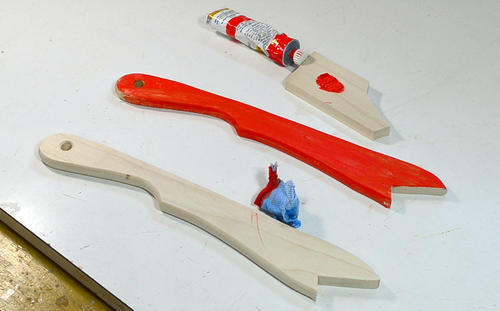What is a push stick for a table saw? A push stick for a table saw is a crucial safety tool used to guide wood through the blade, keeping your hands safely away. This article will guide you through how to create your own, emphasizing table saw safety.

Image Source: woodgears.ca
The Importance of Table Saw Safety and Push Sticks
Table saws are powerful and versatile tools, but they can also be dangerous if not used properly. According to the U.S. Consumer Product Safety Commission, table saws are a significant source of woodworking injuries. Table saw safety should always be paramount in any woodworking project. A push stick is a vital piece of safety equipment designed to help you maintain control of the workpiece while keeping your hands at a safe distance from the spinning blade. Using a push stick helps prevent accidents like kickback and accidental contact with the blade.
Why Use a Push Stick?
- Keeps Hands Safe: The primary function is to keep your hands far from the blade.
- Maintains Control: Provides better control over the wood being cut, reducing the risk of kickback.
- Consistent Cuts: Helps ensure consistent and accurate cuts, especially when working with narrow pieces.
- Prevents Accidents: Significantly reduces the chances of accidental contact with the blade, minimizing injury risk.
Potential Dangers of Not Using a Push Stick
- Kickback: Wood can be thrown back towards the operator with considerable force.
- Blade Contact: Hands can accidentally come into contact with the spinning blade.
- Loss of Control: Difficulty in controlling the workpiece, leading to inaccurate cuts and potential accidents.
Types of Push Sticks and Their Applications
There isn’t just one “best push stick for table saw,” but rather a selection suited to different tasks. Choosing the right type can improve safety and precision.
Standard Push Stick
- Description: A basic, flat piece of wood with a handle.
- Use: Ideal for general ripping operations where a simple push is needed.
- Advantages: Easy to make, versatile for many tasks.
- Disadvantages: Limited grip for narrow pieces.
L-Shaped Push Stick
- Description: Features a “heel” or ledge at the end to grip the back of the workpiece.
- Use: Excellent for ripping narrow pieces and ensuring the wood stays tight against the fence.
- Advantages: Provides secure grip and control.
- Disadvantages: Slightly more complex to make.
Long-Handled Push Stick
- Description: Extended handle for greater reach and control.
- Use: Useful when cutting large pieces of wood or when needing extra distance from the blade.
- Advantages: Increased safety margin, better leverage.
- Disadvantages: Can be bulky and less precise for smaller tasks.
Push Block
- Description: A larger, more elaborate tool often with a comfortable handle and non-slip base.
- Use: Ideal for jointing or face planing operations on the table saw. A push block alternative offers increased surface area for better control.
- Advantages: Enhanced grip and stability.
- Disadvantages: More expensive or time-consuming to make.
Materials and Tools Needed for Your Shop-Made Push Stick
Before starting your DIY push stick project, gather the necessary materials and tools.
Materials
- Hardwood or Plywood: Choose a durable material like maple, oak, or birch plywood. Scrap wood often works well.
- Screws or Glue: For assembling the push stick, if required by the design.
- Non-Slip Material (Optional): Rubber or adhesive-backed sandpaper can be added to the bottom for better grip.
Tools
- Table Saw: To cut the push stick components.
- Measuring Tape: For accurate measurements.
- Pencil: For marking cut lines.
- Clamps: To hold pieces together while gluing or screwing.
- Drill: For pilot holes if using screws.
- Screwdriver: To drive in screws.
- Sandpaper: For smoothing edges and surfaces.
DIY Push Stick: Step-by-Step Instructions
Here are general woodworking push stick plans to guide you in creating a standard L-shaped push stick. Always prioritize safe woodworking techniques during each step.
Step 1: Design and Planning
- Choose a Design: Decide on the type of push stick you want to make (standard, L-shaped, etc.).
- Find a Free Push Stick Template (Optional): Many free templates are available online. Search for “free push stick template” to find one that suits your needs. Alternatively, you can design your own.
- Sketch Your Design: Draw your chosen design on paper, noting the dimensions.
Step 2: Cutting the Pieces
- Prepare the Wood: Select your chosen material and ensure it is free of knots or defects.
- Measure and Mark: Use the measuring tape and pencil to mark the cut lines on the wood according to your design.
- Cut the Components: Using the table saw, carefully cut out the pieces. Adhere to table saw safety procedures.
- Base: The main body of the push stick.
- Handle: The part you will grip.
- Heel (for L-shaped): The ledge that grips the back of the workpiece.
Step 3: Assembly
- Attach the Handle: Position the handle piece on top of the base and clamp it in place.
- Drill Pilot Holes (If Using Screws): Drill pilot holes through the handle and into the base to prevent splitting.
- Secure with Screws or Glue: Use screws or wood glue to attach the handle securely to the base. If using glue, clamp the pieces together until the glue dries completely.
- Attach the Heel (For L-Shaped Push Stick): Position the heel piece at the end of the base, ensuring it is perpendicular.
- Drill Pilot Holes and Secure: Drill pilot holes and attach the heel using screws or glue, clamping until dry.
Step 4: Finishing
- Sand All Edges: Use sandpaper to smooth all edges and surfaces of the push stick. This will make it more comfortable to use and prevent splinters.
- Apply Non-Slip Material (Optional): If desired, apply non-slip material to the bottom of the base for enhanced grip.
- Inspect and Test: Before using the push stick, inspect it thoroughly to ensure all joints are secure and there are no sharp edges. Test it on scrap wood to ensure it functions correctly.
Safety Tips for Using a Push Stick
Using a push stick effectively requires adherence to certain safety guidelines to ensure your safety and the quality of your woodworking.
General Table Saw Safety Rules
- Wear Safety Glasses: Always wear safety glasses to protect your eyes from flying debris.
- Use Hearing Protection: Table saws can be loud; wear earplugs or earmuffs to protect your hearing.
- Keep Hands Clear: Never place your hands directly in line with the blade.
- Use a Push Stick or Push Block: Employ these tools to keep your hands at a safe distance from the blade.
- Stand to the Side: Position yourself to the side of the blade to avoid being in the direct path of potential kickback.
- Check the Wood: Inspect the wood for knots, nails, or other imperfections before cutting.
- Adjust the Blade Height: Set the blade height so that it is only slightly higher than the thickness of the wood being cut.
- Use the Fence or Miter Gauge: Guide the wood using the fence or miter gauge to ensure accurate and safe cuts.
- Never Reach Over the Blade: Avoid reaching over the blade while the saw is running.
- Unplug the Saw: Always unplug the saw before making adjustments or changing the blade.
Specific Push Stick Safety Guidelines
- Choose the Right Push Stick: Select the appropriate push stick for the task at hand.
- Maintain a Firm Grip: Hold the push stick firmly and apply consistent pressure.
- Keep the Wood Against the Fence: Ensure the wood remains tight against the fence throughout the cut.
- Use Two Push Sticks (If Necessary): For long or narrow pieces, use two push sticks to maintain control.
- Replace Worn Push Sticks: If your push stick becomes damaged or worn, replace it immediately.
- Practice Regularly: Familiarize yourself with using the push stick before tackling complex cuts.
Push Stick Design Considerations
The effectiveness of a push stick depends largely on its design. Consider these factors when creating your own.
Ergonomics
- Handle Comfort: The handle should be comfortable to grip and allow for a secure hold.
- Angle of Attack: The angle at which the push stick contacts the wood should be natural and easy to maintain.
Durability
- Material Choice: Use a strong, durable material that can withstand repeated use.
- Construction: Ensure the push stick is well-constructed with secure joints.
Functionality
- Grip: The push stick should provide a firm grip on the wood.
- Surface Area: A larger surface area can provide better control, especially on larger pieces.
Maintenance
- Regular Inspection: Check the push stick regularly for signs of wear or damage.
- Replacement: Replace the push stick when it becomes worn or damaged.
Alternatives to Push Sticks
While push sticks are essential, several other tools can be used in conjunction with or as alternatives to push sticks in certain situations.
Push Blocks
As previously mentioned, push blocks offer a larger surface area and enhanced grip, making them suitable for jointing and face planing.
Featherboards
Featherboards attach to the table saw fence or table and apply pressure to the wood, keeping it tight against the fence. This helps prevent kickback and ensures accurate cuts.
Miter Gauges
Miter gauges are used for making accurate crosscuts and angled cuts. They provide a stable platform for the wood and help maintain control.
Riving Knives and Splitters
These safety devices are installed behind the blade to prevent the wood from pinching the blade, reducing the risk of kickback.
Frequently Asked Questions (FAQ)
-
Can I use any piece of wood as a push stick? No, using just any piece of wood can be unsafe. A properly designed and constructed push stick is essential. It should have a good handle and a shape that allows you to maintain control without your hand getting close to the blade.
-
How often should I replace my push stick? Replace your push stick as soon as you notice any signs of wear, damage, or weakening. Cracks, splits, or a loose handle are all indicators that it’s time for a new one.
-
What is the best wood to use for a push stick? Hardwoods like maple or oak are ideal because they are durable and can withstand repeated use. Plywood is also a good option, especially Baltic birch plywood.
-
Do I need to use a push stick for every cut on the table saw? It is recommended to use a push stick when cutting narrow pieces or when your hands would otherwise be close to the blade. For wider pieces, you may not need a push stick, but always prioritize safety and use one if you feel it is necessary.
-
Are push blocks better than push sticks? Not necessarily. Push blocks offer greater control and are better suited for tasks like jointing. Push sticks are versatile and suitable for a variety of ripping operations. The best choice depends on the specific task.
By following these guidelines, you can enhance your table saw safety and create a valuable tool that will serve you well in your woodworking projects. Remember, table saw safety should always be your top priority. Make a push stick and use it consistently.

Hi, I’m Tom Scalisi, and welcome to The Saw Blog! I started this blog to share my hands-on experience and insights about woodworking tools—especially saws and saw blades. Over the years, I’ve had the chance to work with a wide range of tools, and I’m here to help both professionals and hobbyists make informed decisions when it comes to selecting and using their equipment. Whether you’re looking for in-depth reviews, tips, or just advice on how to get the best performance out of your tools, you’ll find it here. I’m excited to be part of your woodworking journey!
